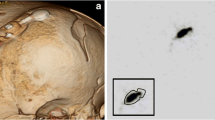Abstract
Introduction
Nuclear medicine shuntograms using the radiotracer technetium-99m diethylenetriaminepentaacetic acid have been used for many years as an additional method to assess shunt patency and performance.
Methods
The medical records of all children who had shuntograms performed at the Children’s Hospital of Eastern Ontario between January 13, 2000, and January 10, 2003, were retrospectively reviewed. There was a total of 68 procedures in 56 patients with an average age of 9 years 3 months. During the same period there were 123 shunt revisions.
Results
Forty-two shuntograms were reported as normal. Of these, ten were identified to be false negative. Two children with fractured shunts had shuntograms performed in order to assess for cerebrospinal fluid flow patency; the shuntograms were identified to be normal, confirming shunt dependence, and the shunt replaced. Twenty-six shuntograms were reported as abnormal in 24 patients; 17 went on to have surgery and the shunt malfunction was confirmed. Seven patients did not require surgery: five were declared shunt independent, two patients clinically improved after severe constipation was treated.
Conclusions
Approximately one fourth of all shuntograms reported as normal are not (false-negative rate=25%). Review of five other major studies between 1980 and 2003 have reported false-negative rates between 2 and 36%, which may be explained by variations in shuntogram protocols. A standardized method is proposed.
Similar content being viewed by others
References
Bartynski WS, Valliappan S, Uselman JH, Spearman MP (2000) The adult radiographic shuntogram. Am J Neuroradiol 21:721–726
Bell RL (1959) Isotope transfer test in the diagnosis and treatment of hydrocephalus. Int J Appl Radiat 5:89–93
Benzel EC, Mirfakhraee M, Hadden TA (1991) Evaluation of CSF shunt function: value of functional examination with contrast material. Am J Neuroradiol 12:143–147
Blair K, AuCoin R, Kloiber R, Molnar CP (1989) The complementary role of plain radiographs and radionuclide shuntography in evaluating CSF-VP shunts. Clin Nucl Med 14:121–123
Bragg CL, Edwards-Beckett J, Eckle N, Principe K, Terry D (1994) Ventriculoperitoneal shunt dysfunction and constipation: a chart review. J Neurosci Nurs 26:265–269
Clyde BL, Albright AL (1995) Evidence for a patent fibrous tract in fractured, outgrown, or disconnected ventriculoperitoneal shunts. Pediatr Neurosurg 2:20–25
Di Chiro G, Grove AS Jr (1966) Evaluation of surgical and spontaneous cerebrospinal fluid shunts by isotope scanning. J Neurosurg 24:743–748
French BN, Swanson M (1981) Radionuclide-imaging shuntography for the evaluation of shunt patency. Surg Neurol 16:173–182
Gilday DL, Kellam J (1973) 111In-DTPA evaluation of CSF diversionary shunts in children. J Nucl Med 14:920–923
Graham P, Howman-Giles R, Johnston I, Besser M (1982) Evaluation of CSF shunt patency by means of technetium-99 m DTPA. J Neurosurg 57:262–266
Kazan S, Acikbas C, Rahat O, Tuncer R (2000) Proof of the patent subcutaneous fibrous tract in children with V-P shunt malfunction. Childs Nerv Syst 16:351–356
Lorber J, Pucholt V (1981) When is a shunt no longer necessary? An investigation of 300 patients with hydrocephalus and myelomeningocele: 11–22 year follow up. Z Kinderchir 34:327–329
May CH, Aurisch R, Kornrumpf D, Vogel S (1999) Evaluation of shunt function in hydrocephalic patients with the radionuclide 99mTc-pertechnetate. Childs Nerv Syst 15:239–245
O’Brien DF, Taylor M, Park TS, Ojemann JG (2003) A critical analysis of ‘normal’ radionucleotide shuntograms in patients subsequently requiring surgery. Childs Nerv Syst 19:337–341
Uvebrant P, Sixt R, Bjure J, Roos A (1992) Evaluation of cerebrospinal fluid shunt function in hydrocephalic children using 99mTc-DTPA. Childs Nerv Syst 8:76–80
Vernet O, Farmer JP, Lambert R, Montes JL (1996) Radionuclide shuntogram: adjunct to manage hydrocephalic patients. J Nucl Med 37:406–410
Vinchon M, Fichten A, Delestret I, Dhellemmes P (2003) Shunt revision for asymptomatic failure: surgical and clinical results. Neurosurgery 52:347–356
Acknowledgements
The authors would like to thank Mr. Scott Walker, technical supervisor of the Nuclear Medicine Unit at CHEO, for all of his expertise and support.
Author information
Authors and Affiliations
Corresponding author
Rights and permissions
About this article
Cite this article
Vassilyadi, M., Tataryn, Z.L., Matzinger, M.A. et al. Radioisotope shuntograms at the Children’s Hospital of Eastern Ontario. Childs Nerv Syst 22, 43–49 (2006). https://doi.org/10.1007/s00381-005-1153-1
Received:
Revised:
Published:
Issue Date:
DOI: https://doi.org/10.1007/s00381-005-1153-1




